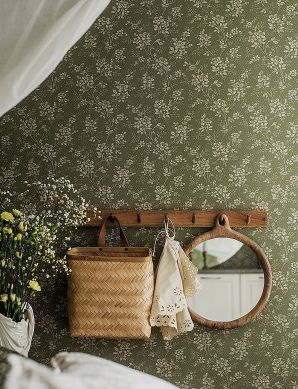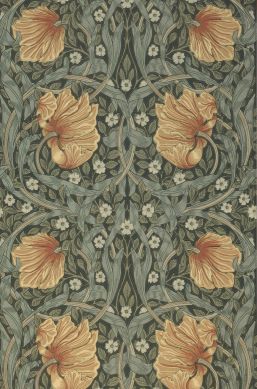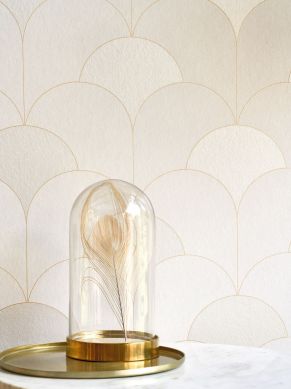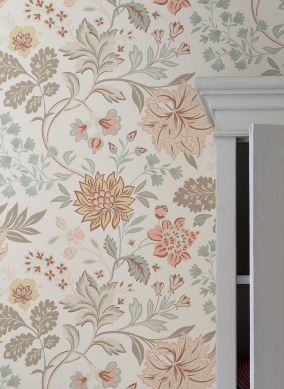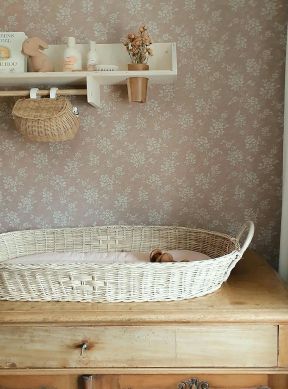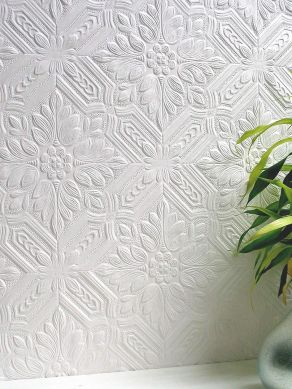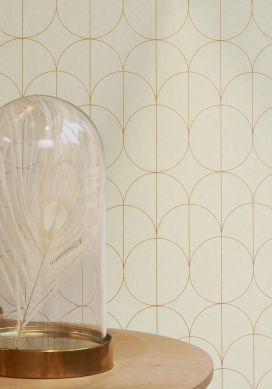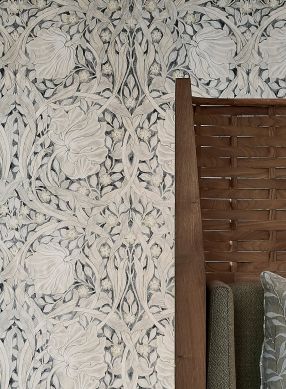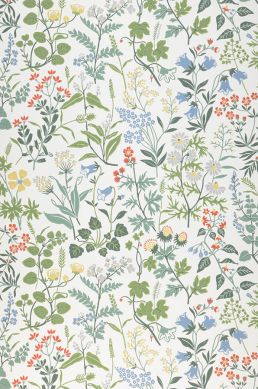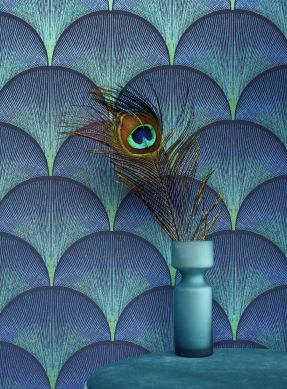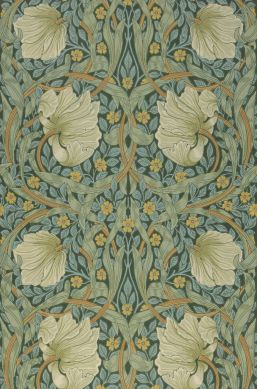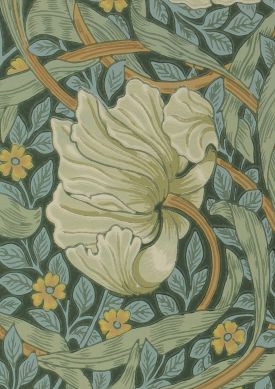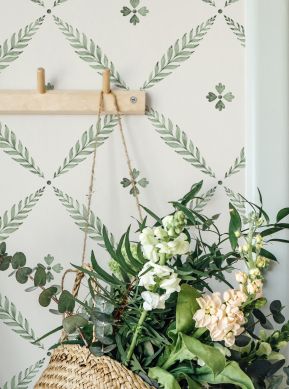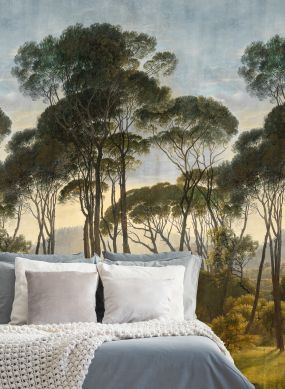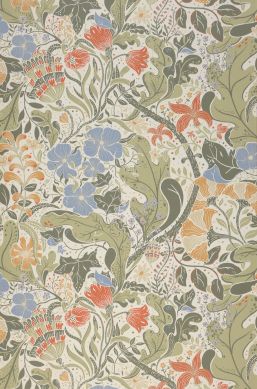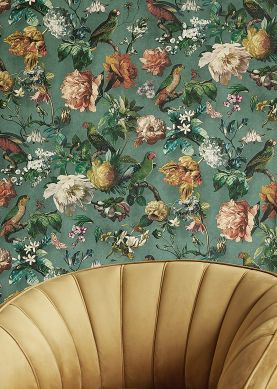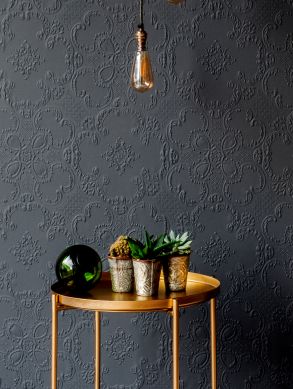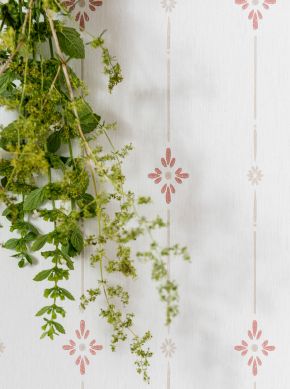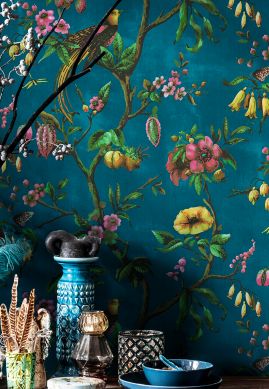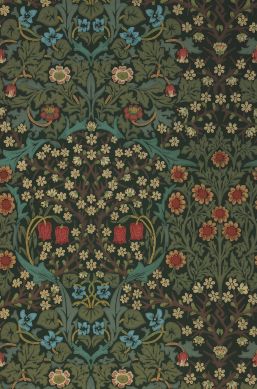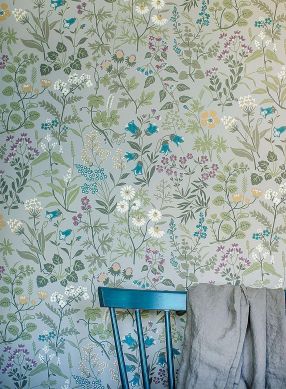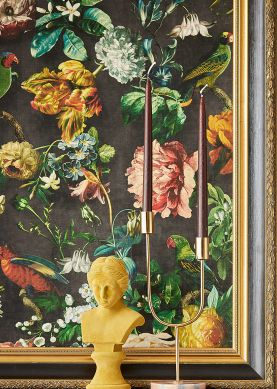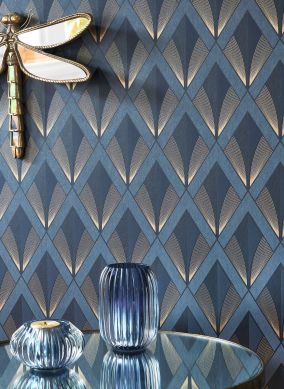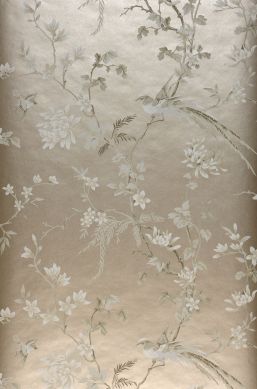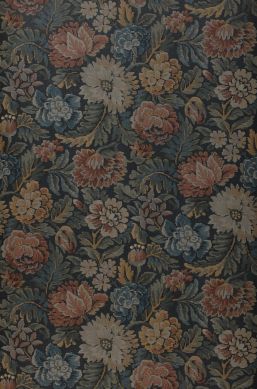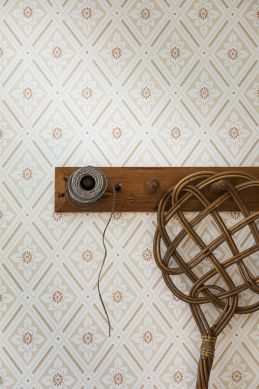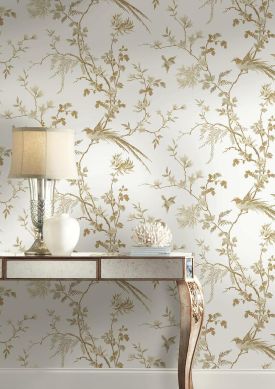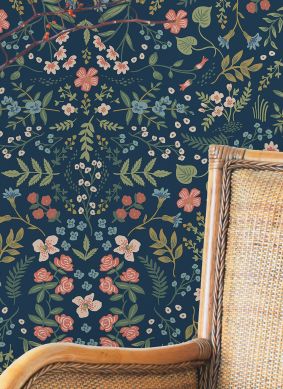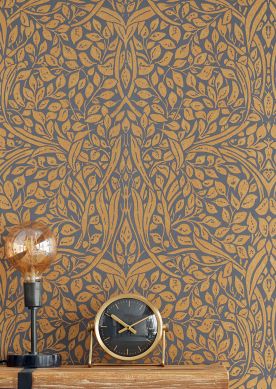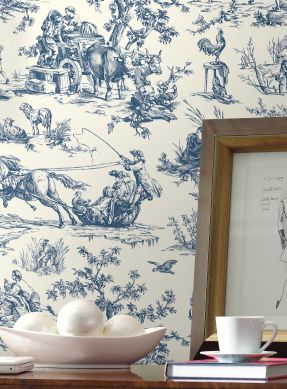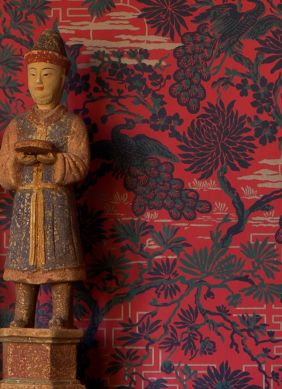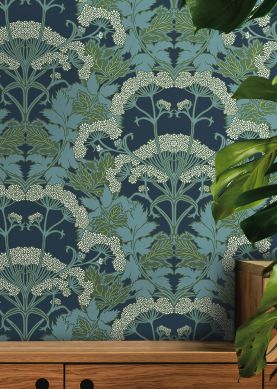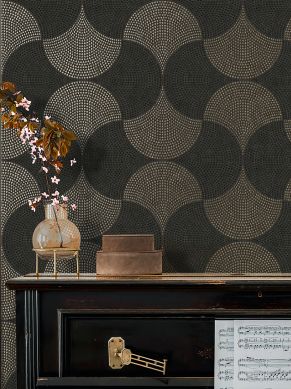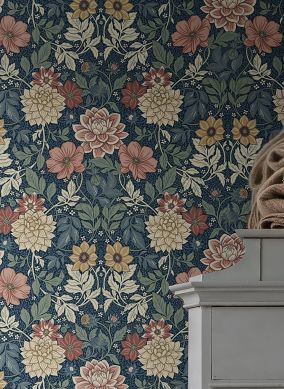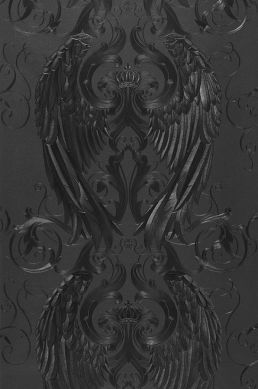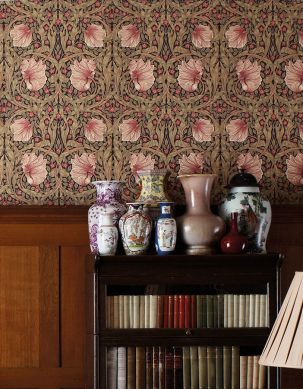Classic Wallpaper
Classic Wallpaper: The Guide
Classic wallpaper styles are characterised by pattern elements and motifs from great periods of time, art and style, e.g. Renaissance, Baroque, and Art Nouveau. The designs of classic wallpaper styles created today are based on historical or antique models. Original old wallpapers with classic patterns are mainly found in museums and archives. Classic wallpapers create an authentic atmosphere, they awaken memories and are the ideal design tools for interiors with a strong reference to a particular style era. But they can also serve as a stylistic contrast for ultra-modern interiors.
Table of Contents
- What is Classic wallpaper?
- Which are the style epochs of historical wallpaper patterns?
- What are the various countries of origin for classic wallpapers?
- What does the term "Antique Wallpaper" refer to?
- Which historical printing processes are used in the production of wallpaper?
- Which colours are typical for classic wallpaper?
- What are popular motifs for classic wallpaper patterns?
- Which rooms are particularly suitable for classic wallpaper?
- What makes classic wallpaper so popular?
- Our tips: Classy décor with classic wallpaper
What is Classic wallpaper?
Classic wallpaper is based on pattern designs of historical style epochs. The term "classic" defines their traditional and enduring character featuring era-specific style elements. Reproductions from the archives also find their way into the wallpaper industry.
Classicism
In the sense of the translation from Latin, classicism is the basis of all progress whilst simultaneously being timeless and everlasting. Classicism connects tradition, cultural development and history. In various fields such as music, literature, visual arts and architecture, the term "classic" is placed in a more specific, even time-limited context.
Style characteristics of historical epochs
Each historical epoch has its own unmistakable stylistic features which provide a direct visual reference. In relation to wallpaper pattern design, opulent ornaments are typical of the Baroque period. These consist of elements such as figurines, flowers, plants, etc. Art Nouveau is characterised by sweeping, organic and floral forms which create strikingly detailed patterns. In Art Deco, clear geometric forms, arches, steps, and angles are characteristic.
Reproductions from archives
Historical wallpapers are guarded like treasures in museum archives. Due to their age, the paper or other materials from which they are made are very sensitive and can react with oxygen and air. Under certain terms, reproductions of historical designs are possible. The old design is skilfully copied or re-interpreted.
Which are the style epochs of historical wallpaper patterns?
Over many centuries, numerous style epochs have been a significant part of history. They still influence art, design and architecture today. Baroque, Rococo, Classicism/Empire, Biedermeier, Art Nouveau, Art Deco or Bauhaus, among others, are all featuring on today's wallpaper patterns.
Baroque (1600 - 1730)
This epoch of European art history is divided into Early Baroque (around 1600 -1650), High Baroque (1650 - 1700) and Late Baroque (until 1730). Italy and France are considered two strongholds for this glamorous style which seeks to express power, opulence and wealth. Symmetrical, curved, convex and concave forms, rich ornaments and strong colours such as gold or purple are characteristic for the Baroque period. Great attention was paid to the quality of craftsmanship.
Rococo (1730 - 1770)
The Rococo developed from the Late Baroque period. France at the time of Sun King Louis XIV, whose Palace of Versailles was designed in the Baroque style, is considered the birthplace of Rococo. As in the Baroque style, the design elements are richly ornamental, but there is also a certain playfulness in its flourishes and romantic aspects. The asymmetrical Rocaille ornament style is at its very centre. Curved lines, tendril-shaped frame elements and exotic components characterise this highly decorative style.
Classicism / Empire (1770 - 1840)
In Classicism, architecture, art and design are inspired by Greek and Roman antiquity. In contrast to the Baroque style, shapes are simple, clear and straightforward. It is the era of elegant salons with dark solid wood furniture and high-quality fabric wallpaper. The Empire era represents a sub-epoch of classicism which began during the reign of French Emperor Napoleon Bonaparte. Roman and Greek antiquity are still the inspiration of this representative style with an opulent, festive character.
Biedermeier (1820 - 1850)
The German Biedermeier (sometimes spelt Biedermaier) era begins after the end of the Congress of Vienna. It's a time of stagnating politics. The upper middle class creates its own world. Life is centred around family and home. Two poets create the conservative and bourgeois philistine Gottlieb Biedermaier, thus giving the era its name. At the same time, the "Biedermaier" attitude stands for typical German virtues such as diligence and honesty. A treasured sense of an idyllic private life inspires the simple elegance of the interior design style.
Art Nouveau (1890 - 1920)
In art history, Art Nouveau is the style that began at the turn of the 19th to the 20th century. Reform and modernism were essential points of reference which this movement took up and derived new ideas from. Art Nouveau opened up a new era in which art and life merged. Art became part of everyday life, function became an important element in design. Amongst the stylistic highlights are large floral ornaments composed of the finest details, as well as beautifully curved lines.
Art Deco (1920 - 1940)
Art Deco is a French and Italian style in design, art and architecture which is characterised by intricate stylising and abstracting. Cubism and Futurism influence the artistic design. Floral and organic motifs are cleverly combined with the strict geometry of functionalism. Influences of foreign cultures, e.g. from Africa or Arabia, also come into play. Luxurious and precious materials are used, including silver, bronze, ebony, crystal and ivory.
Bauhaus (1920 - 1940)
In 1919, Walter Gropius founded the Staatliches Bauhaus in Weimar, Germany. Its main focus is the combination of art and craftsmanship. This famous art school is considered to be the birthplace of the Avant-garde movement. The focus is on modern architecture as a field of experimentation with specific rules. In a "Bauhaus" building, all elements should form a visual and functional unit. Cubist shapes, primary colours, new and clear materials as well as high functionality are essential characteristics of the Bauhaus style.
What are the various countries of origin for classic wallpapers?
Classic wallpaper patterns are often based on country-specific, traditional pattern motifs. As a result, classic wallpapers can be distinguished according to the countries of origin such as England, France, Italy or Sweden.
English
Classic wallpapers from England often feature Victorian pattern motifs. The English cottage style is paid tribute to with hunting and landscape scenes, roses, floral elements or heraldic ornaments. Paisley is another British pattern motif with a long tradition.
French
Classic French wallpapers are characterised by opulent Baroque or Rococo patterns. Other pattern elements include those in the style of the Gothic renaissance. Traditional Toile de Jouy wallpaper models should also be mentioned. The French lily is a popular pattern motif for the Country House style.
Italian
Venetian Baroque and illusionist paintings are both part of classic Italian wallpaper art. Roman mosaic and fresco art, as well as the luxurious aesthetics of marble and terrazzo as traditional patterns, or figurative works in the style of Botticelli et al also characterise the style.
Swedish
Historical Swedish wallpaper designs often feature folklore patterns of Swedish folk art with a tradition that spans centuries. Furthermore, the Gustavian (classicist) style of the aristocracy is a popular model for classic designs. Classic Swedish wallpaper styles are completed by typical country-specific Art Nouveau and Art Deco interpretations.
What does the term "antique wallpaper" refer to?
The illustrative design of antique wallpaper patterns refers to classic architecture and art. The focus is on motifs and fragment patterns from Greek antiquity and the Roman Empire.
Greek antiquity
Greek antiquity is the period from about 1200 BC to 146 AD. This period, the beginning of the development of modern Greece, begat civilization, culture, science and education. Greek antiquity was a pioneering force in all areas of life, including medicine, architecture, literature, philosophy and painting. Antique wallpaper patterns often boast figures from Greek mythology, but also depictions of animals, plants and humans based on old vase and wall paintings.
Roman Empire
The Roman Empire existed between the 8th century BC and the 7th century AD. It was considered the largest empire in the Mediterranean region and covered large parts of Europe. The "Imperium Romanum" went through various periods of political rule, including the imperial period with its heyday under Emperor Trajan (115-117). In palaces and villas, power and opulence were reflected in exquisite floor mosaics, frescoes, fabric coverings or paintings on walls/ceilings as well as precious decorations. These status symbols also adorn ancient Roman wallpaper designs.
Which historical printing processes are used in the production of wallpaper?
Historical, traditional printing processes are ideal for classic wallpapers, especially if the visual effect is to be very authentic. Surface printing and silk-screen printing are at the forefront of the traditional printing processes.
Surface printing
The surface printing process was developed in 1915 by German photographer Heinrich Kühn (1866-1944). For this process, the printing inks are mixed with glue. The introduction of mechanical surface printing with rollers used for wallpaper production replaced the manual printing process. Even today, machine surface printing is used for exclusive wallpapers with an artisan look.
Screen printing
Screen printing is one of the best-known traditional printing methods. The printing ink is applied onto the material through a fine mesh fabric. In places where no ink is to be applied, a stencil is used to make the mesh impermeable to ink. Screen printing is done manually or by machine.
Which colours are typical for classic wallpaper?
The colour spectrum of classic wallpapers ranges from subtle, elegant and neutral to majestic and luxurious. Grey, black/white, beige, red, blue and gold are among the most frequently chosen design colours.
Grey
In darker nuances, grey lends a cool, elegant touch to a classic pattern design and creates a harmonious effect with simple classic furnishing styles. Other colours are emphasised and their effect is intensified.
Red
Red is often associated with love and romance, but it also has a regal character (for instance in shades like fuchsia or crimson), making this colour the first choice for sophisticated classic wallpaper designs.
Beige
In colour psychology, soft, comfortable, grounding and sensual are the terms used to describe this mixed tone. Its natural aura lends exclusivity to classic designs and makes it compatible with many shades of both the warm and the cool colour palette.
Blue
Blue is a splendid ornamental colour, and its royal character gives expressive depth to many pattern wallpaper styles. The colour of clarity also plays an important role in traditional British/Victorian designs or in the folkloristic patterns of Mediterranean countries.
Gold
Gold stands for luxury, wealth, powerful beauty and enlightenment. No other colour is more beneficial for opulent Baroque or Rococo patterns. The colour of the sun also adds a radiant light to Art Nouveau and Art Deco patterns.
Black/white
Classic patterns and motifs can be very subtle and yet profound. They impress with their calm individuality which the neutral colours black and white express to perfection.
What are popular motifs for classic wallpaper patterns?
There is a plethora of pattern/motif possibilities for classic wallpapers. Among the top six most popular designs are stripes, historical landscapes, classic art & painting, flowers, birds, and ornaments of different style eras.
Stripes
Stripes, especially in the shape of straight-lined block stripes, are a typical classic wallpaper pattern. Following historical pattern templates, many stripe designs are embellished with enchanting birds and romantic flowers. In terms of colour, gold, rosé, hues of brown and cream, but also black and white are in demand.
Historical landscapes
Culturally and historically significant landscapes can be found all over the world and satisfy the romantic longing for home and family. French Toile de Jouy wallpaper or Delft tile motifs are just two examples. In England and Scotland, forest landscapes and hunting scenes dominate, whereas in the far north it's representations of the rugged coast.
Classical art & painting
Classical art and painting provide excellent templates for wallpaper designs. Works of old masters from different historical art movements, e.g. Botticelli, Michelangelo, Rembrandt, Renoir, van Gogh, Klimt, are re-interpreted in a designer-specific way.
Flowers
Flowers were a significant stylistic device in various art epochs (Baroque, Art Nouveau) and a form of expression in romanticism. Traditional motifs, amongst others, are the blue flower (cornflower) or the lily, which is often part of traditional family coats of arms. Flower bouquets and historical floral designs are also represented on classic wallpaper.
Birds
Just like flowers, birds exude a romantic character. In the 17th and 18th centuries, exotic birds from foreign continents were en vogue at the courts of the European nobility, and depictions of tropical birds found their way into decorative painting.
Ornaments
Ornaments are essential elements of certain styles, including Renaissance, Victorian, Baroque, Art Nouveau and Art Deco. In classical Modernism, they have continuously been altered or modified in line with each respective art movement. Furthermore, there are influences from the Orient as well as from fairy tales and legends, adding versatility and variation to the ornaments.
Which rooms are particularly suitable for classic wallpaper?
Pattern motifs typical of classic wallpapers can be used for personal retreat areas as well as representative, sociable spaces. Bedrooms, bathrooms, living rooms, kitchens and hallways benefit greatly from wallpaper models with classic designs.
Bedroom
Bedrooms are exceedingly suitable for tasteful wallpaper ideas reminiscent of bygone times. The boudoir also provides plenty of room for fairytale fantasies, for example with premium-quality patterned wallpaper in the style of historical palaces or castles. Our tip: Historical landscape motifs for a sleep-inducing atmosphere.
Bathroom
Bathrooms in the style of Ancient Rome or based on Art Nouveau and Art Deco are enjoying a renaissance. Opulent, colourful damask ornaments are meeting the demands of the luxury bathroom. In the area of grooming and well-being, large classical interior design concepts (e.g. with Greek or Roman-inspired motif wallpapers) are a sensual treat.
Living room
Any stylistic theme can be implemented in the living room with classic pattern designs. The Blue or Green Salon, the British "Smoking Room" with depictions of hunting, or a charming Rococo parlour are just a few examples. High-quality materials and opulent colours underline the representative character.
Hallway
Depending on its size and layout, the hallway is open to versatile classic designs, e.g. stripes. Patterns that tell a story and carry thoughts away into other worlds are particularly suitable. Classic wallpapers with great detail and surprising colours and structures are perfect for this purpose.
Kitchen
Traditional and folkloric patterns (e.g. in the Country House style) are great for kitchens. Delicate flower patterns, Scottish tartan, Toile de Jouy: Wherever a contrast to modern styles is required, classic wallpaper is a great choice (for instance combining an unusual damask pattern with ultra-modern kitchen furniture).
What makes classic wallpaper so popular?
Classic wallpaper never goes out of fashion. On the contrary: depending on the contemporary interior design style, it can become hip and trendy again. It satisfies the longing for nostalgia and aesthetics, and many of the models are available in luxurious finishes for upscale interiors.
The timeless elegance of classic styles
The timeless elegance of classic wallpapers is like an open invitation to decorate in line with personal preferences, moods and trends. The different styles of classic wallpapers provide a wide range of design possibilities relating to individual tastes. Patterns can be opulent, playful, ornate, sober or straight-lined.
Luxurious designs in a brocade and damask look
For countless classic pattern wallpapers, luxury and first-class quality go hand in hand. For example, there is a plethora of opulent Baroque or Art Deco wallpaper models in brocade and damask looks. Even the finest silk fibres or high-quality linen are not uncommon in classic wallpapers.
Nostalgia & aesthetics
Classic wallpaper brings back memories, perhaps of the wall décor in grandmother's living room. But nostalgia also refers to wallpaper decoration creating the authentic atmosphere of a particular style era. Not forgetting the beauty that emanates from strikingly artistic designs...
Our tips: Classy décor with classic wallpaper
- Old wallpaper for dolls houses: Children's eyes will light up when the walls of their dolls' house are decorated with design wallpaper in the style of Biedermeier, Baroque or Art Nouveau. The best option are very delicate small-scale patterns so that the proportions match the scale.
- Wallpaper matching antique furniture: Furnish the room according to an old interior design style template. Use original photos from books, magazines or the internet to find out which wallpaper matches the furniture. Complete the interior with authentic accessories and lighting.
- Flower renaissance in a panelling look: Apply paintable lining paper to the wall. Now choose an atmospheric wallpaper, for instance with flower bouquets, and cut 2 - 4 strips according to the length of the wall (approx. 120 cm long and 50 cm wide - other formats are also possible). Apply the lengths of wallpaper at equal distance to each other, so that a harmonious effect is created. Paint the white spaces between the lengths in one of the colours present in the wallpaper. Then surround the wallpaper with moulding strips to form panels.
- Gorgeous blossoms for the living area: A cream-white or champagne-coloured glass bead wallpaper with glittering beads forming ornaments provides an exquisite touch of luxury. Combined with velvety soft settees and armchairs in grey-rosé and decorative objects in copper or bronze, the effect is breath-taking.


